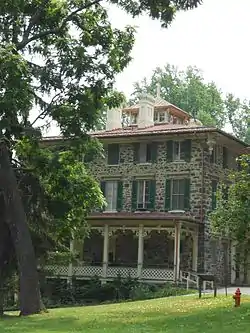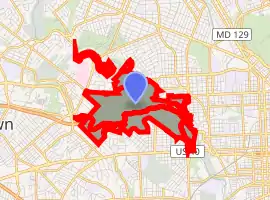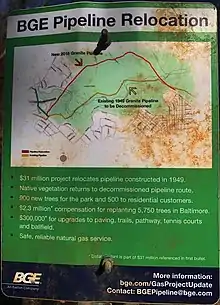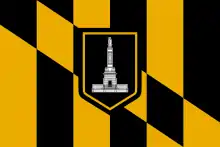Gwynns Falls Leakin Park
The contiguous 1,200 acres of Gwynns Falls/Leakin Park constitute the largest woodland park in an East Coast city. Envisioned as a “stream valley park” to protect Baltimore’s watersheds like the Gwynns Falls from overdevelopment and to preserve their natural habitats, Gwynns Falls/Leakin Park today offers a rare opportunity for the public to explore a diverse natural environment characterized by stream valleys, ridge tops, and meadows; enjoy opportunities for active recreation; and experience historic structures from an earlier era.
| Gwynns Falls/Leakin Park | |
|---|---|
 Orianda Mansion ("Crimea") in Gwynns Falls/Leakin Park | |

| |
| Location | 4921 Windsor Mill Road Baltimore, MD 21207 |
| Coordinates | 39°18′23″N 76°41′27″W |
| Area | 1,216 acres (492 ha) |
| Created | 1908 |
| Operated by | Baltimore City Department of Parks and Recreation |
Gwynns Falls/Leakin Park, designated as part of the Baltimore National Heritage Area, is managed and maintained by Baltimore City Department of Recreation and Parks, assisted and supported by volunteers of the Friends of Gwynns Falls/Leakin Park (FOGFLP).
Overview
Providing a green canopy for Baltimore City’s west side, the park incorporates the valleys of the Gwynns Falls and its tributaries, extending more than six miles from the western municipal limits south to Wilkens Avenue. Along its borders are twenty of the city’s neighborhoods. Today’s visitors may find themselves agreeing with an 1831 traveler who expressed surprise at discovering the valley’s “wild and beautiful scenery . . . so near the city, surrounded by all the various majestic features of a rocky mountainous country.”[1]
Outdoor recreation
The Eagle Drive Entrance to the Crimea section
Along Windsor Mill Road, the Eagle Drive Entrance to the park provides access to railroad-themed park amenities: the historic structures of railroad builder Thomas Winans, as well as such family activities as miniature train rides and an RR playground. Features from the Winans Crimea Estate era include the stone Orianda mansion and carriage house and the Carpenters Gothic Winans Chapel—all three on the City’s list of historic landmarks.[2] Visitor parking is located near the entrance.
Facilities in this section include the headquarters of the Chesapeake Bay Outward Bound School, with its outdoor activities programs, and the Carrie Murray Nature Center, named for the mother of Baltimore Oriole great Eddie Murray,[3] with year-round programs providing young people opportunities “to meet live animals, explore the park, and develop a relationship with the natural world.” For active recreation, this section includes tennis courts, with plans for improved sports playfields, and access to woodland trails.
Gwynns Falls Trail, Leon Day Park, and Winans Meadow
The Gwynns Falls Trail extends the length of Gwynns Falls/Leakin Park from the terminus of I-70 to Wilkens Avenue, then proceeds with alternate destinations to the Inner Harbor and the Middle Branch. Constructed in stages from 1999 to 2008, the trail opened the stream valley to active recreational use for hikers and bikers, with trailheads and provision for parking along the route.[4][5][6] Interpretive panels tell the history of the stream valley. Visit the Gwynns Falls Trail website for more details, history, and route information.
The project also contributed new amenities along Franklintown Road for Gwynns Falls/Leakin Park, creating playfields that were designated Leon Day Park, in honor of Baltimore’s Negro leagues' great.[7] It also provided greater public access to the park at Winans Meadow, including visitor parking, a covered pavilion for group use on a permit basis, and access to trails that extend from the valley to the park's uphill ridges.
Other hiking trails
The park is an ideal spot for walking, hiking, running, bicycling, and dog walking, although some would say that being in the presence of an abundance of nature tops the list. There are approximately eighteen identified hiking trails in GFLP that are listed on the Gwynns Falls/Leakin Park Trail Map. Most of the trails are in the Winans Meadow and Crimea areas of the park. Trails are unpaved with the exception of a few trails that utilize sections of the Gwynns Falls Trail. Trails fall into the easy to moderate level with some rocky sections, rolling hills, and the occasional muddy area.
A popular trail is Heide's Trail, formerly the Ridge Trail, which runs along a ridge in an east/west direction, allowing for beautiful views of Winans Meadow and the Dead Run stream in the valley and several stands of very tall old trees. Along the Old Fort Trail there are several historic structures from the Winans Estate and, depending on the season, a great view of the back of the Orianda Mansion.
There are ten short hiking trails in the Winans Meadow area (accessible from Franklintown Road) and the Crimea area (accessible from Windsor Mill Road), which permit hikes of varying lengths, challenges and exposures. Longer hikes can be taken into different sections of the park via the Gwynns Falls Trail, the Dickeyville spur, the Windsor Hills Conservation Trail, and other trails that parallel Gwynns Falls. The Millrace section of the Gwynns Falls Trail (once a water power source for mills downstream and the only part of the route not paved) is a particularly scenic area with exceptional view of the Gwynns Falls. Parking for this section is available at the Windsor Mill Road Trailhead of the Gwynns Falls Trail.
Many hiking options are available to meet the desires of beginner and seasoned hikers and explorers. There is a historic estate to explore, relatively undisturbed forest areas, streams, a Sacred Labyrinth, a restored Magnolia Grove, and of course, the birds, bees, and other wildlife that make GFLP their home.
Activities and events
Carrie Murray Nature Center
Carrie Murray Nature Center is operated by Baltimore City Recreation and Parks, and it offers environmental education programs for children, families and adults. Their programs serve an estimated 30,000 visitors annually, serving individuals and families as well as groups from schools, faith-based groups, recreation centers, and camps. During the school year, the nature center offers field trips and outreach programs for students of all ages including the Wild Haven forest immersion program for preschool-age children. They also offer summer camps, public programs, special events, and volunteer opportunities.
Chesapeake Bay Outward Bound School
Chesapeake Bay Outward Bound School (CBOBS) is an educational nonprofit that operates one of its two campuses inside Gwynns Falls Leakin Park. Their character education programs focus on teaching social emotional learning (SEL) skills to middle and high school youth, with programs available for educators, professional teams, and veterans as well. CBOBS has served nearly 100,000 students since being established in 1986, over 90% of which receive some form of scholarship to attend Outward Bound. Programs range from one-day high ropes teambuilding to multi-week wilderness expeditions taking students backpacking, rock climbing, canoeing or sea kayaking across the Chesapeake Bay Region.
Second Sundays in the park
Chesapeake & Allegheny Live Steamers operates a miniature steam-powered railroad with 3,400 feet of track, and provides free rides every second Sunday, April through November.[8] On those days the Friends of Gwynns Falls/Leakin Park provide information, family-friendly activities, and visits to the historic structures. The Carrie Murray Nature Center is also open for visitors.
Baltimore Herb Festival
A group of volunteers who had been active in the fight against the expressway decided to conduct the Baltimore Herb Festival as an annual event in the park, with proceeds going towards its maintenance and preservation.[9] The first festival, held in 1987, proved successful in attracting a large crowd, but it ended in tragedy when lightning from an abrupt thunderstorm struck the chapel where many had taken refuge, injuring several and taking one life.[10][11] Despite this bittersweet inaugural event, the festival has continued to be held annually on the Saturday of Memorial Day Weekend, drawing about 2,000 visitors to the park for the event, which features herb and plant vendors, displays by area organizations, food, and musical entertainment.[12][13]
Leakin Park Parkrun
Leakin Park Parkrun is a free weekly 5k run/walk held on Saturday mornings, starting at Winan's Meadow near Ben Cardin Pavilion[14]
Volunteer opportunities
The nonprofit organization Friends of Gwynns Falls Leakin Park (FOGFLP) organizes volunteers to perform ongoing maintenance of the park, including daily trash collection, trail work, tree plantings and gardening. They also provide assistance by supplying maps to visitors, monitoring park usage, reporting conditions to Baltimore City Recreation & Parks, and much more. FOGFLP also sponsors annual activities such as the MLK Day of Service, the First Day Hike, seasonal hikes, and the Black Friday Hike.
History
Establishing the parks: the Olmsted role
Gwynns Falls/Leakin Park traces its earliest history to a small tract near Edmondson and Hilton Avenues, designated in 1901 as the Gwynns Falls Reserve. In 1904, as the City anticipated expanding its borders through annexation, the highly-regarded Olmsted firm proposed creating “stream valley parks” to protect distinctive watersheds like the Gwynns Falls from future development and secure them as natural preserves.[15] Over the next decades, the Olmsteds worked with the city in its acquisition of park land extending to Windsor Mill Road.
In 1926, following the 1918 annexation, the City again commissioned the Olmsteds for a study of park needs to the year 1950.[16] This report recommended extending Gwynns Falls Park northward along the stream to the City boundary. It also urged acquiring the valley of a tributary, the Dead Run, “considered by all who view it as one of the very best bits of scenery near Baltimore.”
In 1939 Frederick Law Olmsted Jr. was again consulted, this time to evaluate options for the use of the bequest of Baltimore lawyer J. Wilson Leakin for the establishment of a park in the name of his grandfather, a former City mayor. The issue was politically contentious, as various sections of the city competed for selection. Olmsted Jr. strongly recommended acquisition of the Winans Estate, Crimea, which included the valley of the Dead Run and the heights above, as “ so nearly in condition, just as it now is, to be a very beautiful and valuable park.”[17][18][19] The availability of the Winans Estate for purchase as late as the 1940s offered a rare opportunity for a park acquisition of this size within the City limits. With purchases in 1941 and 1948, the City created Leakin Park, the name adhering to the bequest. Since Gwynns Falls and Leakin Parks are contiguous, over time the City’s Department of Recreation and Parks came to designate the combined parklands as Gwynns Falls/Leakin Park.[20]
The Winans Estate
The Winans Estate, acquired to become Leakin Park, was property purchased by Thomas DeKay Winans in the 1850s. The son of B&O railroad builder Ross Winans, Thomas had accompanied his brother William to Russia in the 1840s to construct that country’s first railroad, connecting St. Petersburg and Moscow. While there, Thomas met and married his wife Celeste. Upon completion of the project, the Winans returned to the U.S. in the early 1850s with considerable wealth. Establishing their home as a city mansion, they purchased property in the countryside, naming their estate the Crimea and their country home Orianda—names evoking the Russia where they met. At Celeste’s request, the couple erected a chapel for the religious needs of the Irish workers on the estate. Sadly, shortly after its completion in 1861, Celeste died.[21][22]
Three structures in the park from the Winans era—the stone Orianda mansion and carriage house and the wooden chapel--have been designated Baltimore City Landmarks; they are easily visible from the park’s Eagle Drive. The hillside and valley below also feature remnants from the Winans period, including the ruins of a mock fort and farm buildings, as well as an iron water wheel—one of the park’s most visited sites--apparently designed to pump water up to the mansion. These sites are accessible by hiking trails from Eagle Drive or from the Winans Meadow parking entrance along Franklintown Road.
Expressway threat
Shortly after the establishment of Leakin Park, it and adjacent Gwynns Falls Park were threatened when funding for the federal Interstate Highway System fueled local plans that envisioned the route of an east-west bisecting their lands. As plans developed and acquisition of properties got underway, community activists in various communities across the City organized in opposition. A group committed to protecting the parks took the name of Volunteers Opposed to Leakin Park Expressway, or VOLPE--the acronym a play on the name of the federal Secretary of Transportation.[23][24][25] Taking their opposition to court, VOLPE won a partial victory in 1972 when federal judge James R. Miller, Jr., ruled that provision for hearings on the park route had been “legally insufficient” and ordered new ones to allow full consideration of the environmental impact of the highway plans.[26] In response, a Baltimore Sun editorial acknowledged the need to address transportation demands, but wondered, “Must a city destroy parks, dwellings and businesses in order to accommodate the automobile?”
Protracted hearings and court proceedings due to the activism of expressway opponents had the effect of prolonging the roadway plans past funding deadlines.[27][28] By 1980, with time to use or lose the funds pressing, City officials reached the decision to abandon the proposed route through the park.[29]
Pipeline controversy

In 2013 the Friends of Gwynns Falls/Leakin Park learned of a BGE plan to run a new natural gas pipeline for a 2-mile distance through the park, threatening a substantial number of the park’s trees. BGE spokespersons explained the new line would replace an original one installed with park department permission in 1949, which was now facing considerable maintenance problems. However, a new line could not follow the existing route due to current environmental regulations protecting wetlands, so the proposed new route would run along the ridge near the southern border of the park. Especially troubling to FOGFLP leaders was BGE’s requirement that the construction phase would entail a 75-foot clear-cut corridor requiring removal of a large number of the park’s finest trees, to be maintained at 40 feet afterwards for repair access and monitoring.[30] In an editorial on the controversy, the Sun insisted that “BGE must work with the city and other stakeholders to find the least damaging route for a new gas line through the area.”[31] In response to the concerns raised, BGE agreed to consider an alternative northerly route through the park, following existing park roads, minimizing tree loss, and impacting fewer residences by its proximity to them. After four years of dialogue and studies of route feasibility, BGE began construction along the alternative route in 2018,[32] completing the work in the fall of 2019. Following completion, 870 replacement trees were planted along edges of the corridor.[33][34] As Sun writer Tim Wheeler observed in 2013, “One of the largest urban woodland parks in the eastern United States appears destined to become less wooded.”[35]
Overcoming a stigma
At the end of the 20th century, Leakin Park had a negative reputation connected with crime. It was nicknamed "the city's largest unregistered graveyard,"[36] and a ghoulish webpage was created to track victims' bodies found in the park.[37]
But in truth, the park's 1,216 acres are a safe and restorative place to hike in the woods, bike on paved trails, and enjoy playgrounds. Molly Gallant, a planner with the Baltimore City Department of Recreation and Parks, led successful efforts to change the park's reputation, starting in 2011 with a community-based campout in the park and the closure of dead-end access roads. The Gwynns Falls Trail (which extends from the terminus of I-70 to the Inner Harbor) is a model urban hiking and biking trail that runs around and through GFLP, welcoming cyclists and hikers from around the region. In the words of Rona Kobell, a former Sun reporter writing in Slate,[38]
... a city was and is willing to embrace a wild, wide space inside its boundaries. So Leakin Park is also about the elderly Koreans who gather chestnuts every fall, about the middle-aged black women who began playing tennis there after Arthur Ashe won the U.S. Open, about the truly outsider art gallery along some of the park's trails.
References
- A Natural Legacy: Baltimore’s Gwynns Falls and Leakin Parks, UMBC Community Studies Project, 1986
- Historic Landmarks #59: Crimea House, Chapel, Stables (1982)
- “Pay-Raise Payback: Eddie Murray Plans to Build Camp for Kids,” Afro-American (1893-1988); Baltimore, Md. [Baltimore, Md]17 Aug 1985: 9.
- “The Urban Wilderness; Trails: Phase I of the Gwynns Falls Trail Opens Saturday, and It Represents a Big Step Forward in Reclaiming Leakin Park, ” Remesch, Karin. The Sun; Baltimore, Md. [Baltimore, Md] 03 June 1999: 3.
- “West Baltimore's Appalachian Trail; Greenway: Ground-breaking on 4.5-mile Path Through Leakin and Gwynns Falls Parks,” The Sun; Baltimore, Md. [Baltimore, Md] 02 Dec 1997: 20A.
- “Urban Nature Trail Tells Story of City’s Past; Historic Historical Scavenger Hunt, Outdoor Art Celebrate 15-Mile Gwynns Falls Trail,” Malik, Alia. The Sun; Baltimore, Md. [Baltimore, Md] 23 June 2007: 1B.
- “Take Me Out to the Leon Day Park; Hundreds Celebrate Dedication of 15 Acres in Late Ballplayer's Honor, “ Smith, Jamie. The Sun; Baltimore, Md. [Baltimore, Md]24 Aug 1997: 3.B.
- Chesapeake & Allegheny Live Steamers. Chesapeake & Allegheny Stream Preservation Society (September 7, 2010).
- “Mary Louise Wolf, 75, Engineer Who Founded Local Herb Festival,” Rasmussen, Frederick N. The Sun; Baltimore, Md. [Baltimore, Md] 10 Dec 1998.
- “NPA Official Hit by Lightning Dies in Hospital,” The Sun (1837-1995); Baltimore, Md. [Baltimore, Md]25 May 1987: 1D.
- “2nd Herb Festival Downplays '87 Tragedy,” Kladko, Brian. The Sun (1837-1995); Baltimore, Md. [Baltimore, Md] 29 May 1988: 26.
- “The Spice of Life: Aromatic Festival in Baltimore Park Attracts Herb Enthusiasts,” Kim Chappell Special to the Washington Post, May 31, 1990.
- “Leakin Park to Host 'Largest Herb Event in the Country,’” Linda Lowe Morris. The Sun (1837-1995); Baltimore, Md. [Baltimore, Md] 20 May 1989.
- "Leakin Park parkrun". Friends of Gwynn's Falls/Leakin Park. Retrieved April 21, 2019.
- Olmsted Brothers, Report Upon the Development of Public Grounds for Greater Baltimore (1904; reprint by Friends of Maryland’s Olmsted Parks & Landscapes)
- Olmsted Brothers, Report and Recommendations on Park Extension for Baltimore (1926; reprint by Friends of Maryland’s Olmsted Parks and Landscapes)
- “F.L. Olmsted [Jr.] Is Enlisted in Park Problem: Expert Starts Survey Of Sites Proposed For Leakin Project: Expected To Make Report Soon To Municipal Art Society,” The Sun (1837-1995); Baltimore, Md. [Baltimore, Md]15 June 1939: 26.
- “Final Action Tonight On Leakin Park Site,” The Sun (1837-1995); Baltimore, Md. [Baltimore, Md] June 1940: 26.
- Crimea Estate as Leakin Park Site: Council Committee In 5-To-2 Vote For Dead Run Valley Tract: Selection Is Expected In Next Three Weeks,” Baumgart, Franklyn L. The Sun (1837-1995); Baltimore, Md. [Baltimore, Md] 01 June 1940: 26.
- W. Edward Orser, The Gwynns Falls: Baltimore Greenway to the Chesapeake Bay (Charleston: History Press, 2008)
- “Architectural Treasures Nestled in Leakin Park: Jacques Kelly In the Neighborhood,” Kelly, Jacques. The Baltimore Sun; Baltimore, Md. [Baltimore, Md]21 Nov 2015: A.3.
- Friends of Orianda House: [accessed December 29, 2020]
- Expressway Design Hearing Is Tonight,” Dilts, James P. The Sun (1837-1995); Baltimore, Md. [Baltimore, Md]25 May 1971: A9
- “The Changing City: Who Wants The Expressway?” Dilts, James D. The Sun (1837-1995); Baltimore, Md. [Baltimore, Md] 06 June 1971: SD3
- “Baltimore's Expressway Debate,” The Sun (1837-1995); Baltimore, Md. [Baltimore, Md] 20 Dec 1972: A12.
- “Leakin Park Expressway Given Its Day in Federal Court,” Rehert, Isaac. The Sun (1837-1995); Baltimore, Md. [Baltimore, Md] 25 Jan 1972: B1.
- “Highway Men May Try Again for Leakin Route,” Dilts, James D. The Sun (1837-1995); Baltimore, Md. [Baltimore, Md] 30 June 1975: C14.
- “Debate and Discussion: Leakin Park, a Disputed Highway Route,” Douglas S. Tawney, George L Scheper. The Sun (1837-1995); Baltimore, Md. [Baltimore, Md] 07 Feb 1976: A12.
- “Funds short for Leakin, 1-83 Routes: City Finance Chief Cites Inflation, Drop in Gas Tax Revenue,” Pietila, Antero. The Sun (1837-1995); Baltimore, Md. [Baltimore, Md] 06 May 1980: C1.
- “Park Pipeline Stirs Furor: BGE Plans to Replace Aging Natural Gas Line that Runs through Gwynns Falls/Leakin Park,” Wheeler, Timothy B. The Baltimore Sun; Baltimore, Md. [Baltimore, Md]26 Sep 2013: A.1
- “The Trees at Leakin Park: Our View: BGE Must Work With the City and Other Stakeholders to Find the Least Environmentally Damaging Route for a New Gas Pipeline through the Area,” The Baltimore Sun; Baltimore, Md. [Baltimore, Md]30 Sep 2013: A.12.
- “BGE to Spend $31 Million to Replace Baltimore's First Gas Pipeline through Leakin Park,” Colin Campbell, The Baltimore Sun, Apr 19, 2018.
- Baltimore City, Department of Recreation and Parks, “Granite Pipeline Project”: [accessed December 28, 2020]
- GE web site: Granite Pipeline Relocation: [accessed December 28, 2020]
- “Park Pipeline Stirs Furor: BGE Plans to Replace Aging Natural Gas Line that Runs through Gwynns Falls/Leakin Park,” Wheeler, Timothy B. The Baltimore Sun; Baltimore, Md. [Baltimore, Md]26 Sep 2013: A.1
- Hermann, Peter. "Urban oasis turns into a graveyard Slaying victims are found frequently in city's Leakin Park". Baltimore Sun. Retrieved 20 November 2014.
- Worthing, Ellen (January 6, 2011). "The Bodies of Leakin Park". Blogspot. Retrieved November 21, 2014.
- Kobell, Rona (November 17, 2014). "Where West Baltimore Brings Its Dead". Slate. Retrieved November 21, 2014.
External links
- Gwynns Falls/Leakin Park Baltimore City Department of Recreation and Parks
- Friends of Gwynns Falls/Leakin Park
- Gwynns Falls Trail Map of Gwynns Falls Trail with Leakin and Gwynns Falls Parks
- Carrie Murray Nature Center
- Chesapeake Bay Outward Bound School
- Baltimore Herb Festival
- Crimea Estate at Leakin Park at Explore Baltimore Heritage

